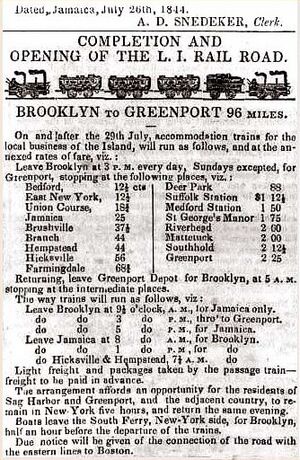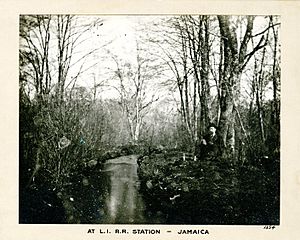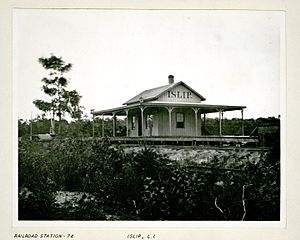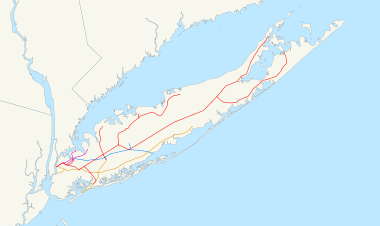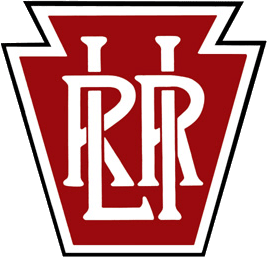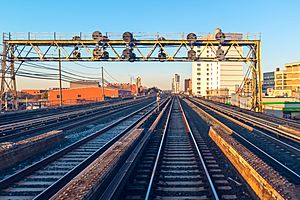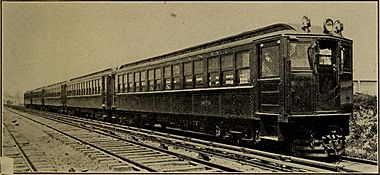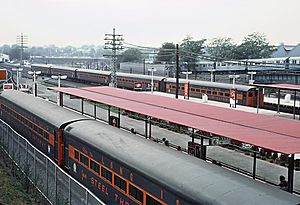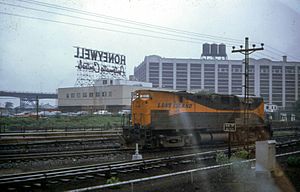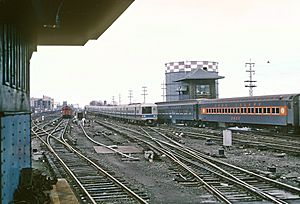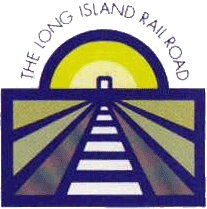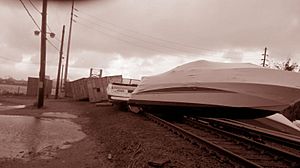History of the Long Island Rail Road facts for kids
The Long Island Rail Road (LIRR) is a railway owned by the Metropolitan Transportation Authority (MTA) in New York. It is the oldest railroad in the United States that still uses its original name and was started under its first official document. In the late 1800s, it joined with several other companies. The Pennsylvania Railroad owned the LIRR for most of the 1900s, selling it to New York State in 1966.
Contents
Early Days: Connecting New York and Boston (1832–1840s)
The LIRR's story began on April 25, 1832, with the Brooklyn and Jamaica Rail Road. This company planned to build a ten-mile line from the East River in Brooklyn to Jamaica, Queens. An engineer named Major D. B. Douglass soon started planning a longer route. This route would be part of an 11-hour trip combining trains and steamboats between New York City and Boston. At that time, the land route through southern Connecticut was too difficult to build on because of many hills and rivers.
Wealthy New Yorkers and Bostonians liked Douglass's idea. They received a special document on April 24, 1834, to create the Long-Island Rail-Road Company. This document allowed them to build a railroad from Greenport to Brooklyn and Williamsburg, Brooklyn. They could also build a branch line to Sag Harbor, New York. The LIRR decided to build its main line straight through the middle of Long Island. This area was mostly empty, which made it easier and faster to build the tracks. It also meant fewer places where the tracks would cross roads. The LIRR officially started on June 17, 1835.
The Brooklyn and Jamaica line opened on April 18, 1836, running along what is now Atlantic Avenue in Brooklyn. The LIRR leased this line immediately for $33,300 a year, hoping for lots of passengers traveling to Boston. The LIRR quickly began extending the line past Jamaica, reaching Hicksville on March 1, 1837. Building stopped for four years due to a money crisis in 1837. The entire line had one track, but it was built wide enough for two.
In 1839, a short branch line to Hempstead opened, running south from the main line at Mineola. The LIRR slowly continued building east, reaching Farmingdale in 1841 and Deer Park in 1842. Finally, the main line was finished, and trains began running all the way to Greenport on July 29, 1844. The trip took three and a half hours. Since the route went through the middle of the island, people from towns on the north and south shores had to travel several miles by stagecoach to reach the train.
The LIRR bought a steamboat called Cleopatra to carry passengers across Long Island Sound to Stonington, Connecticut. Service started on August 10. In 1845, the LIRR added more steamboats and a second route to Boston. However, new railroads and steamboat lines caused a lot of competition. By early 1847, the LIRR sold its steamboats, ending its express service to Boston.
Focusing on Long Island (1840s–1875)
In December 1848, a new railroad opened through Connecticut, creating an all-land route to Boston. This was a big blow to the LIRR's Boston service. The LIRR was not built to serve local towns on Long Island, and it took many years for it to change its focus. The LIRR faced financial trouble in 1850 but recovered. Most people on Long Island lived closer to the shores, not the middle of the island where the LIRR tracks were. In 1862, the LIRR was allowed to build new branch lines anywhere east of Jamaica.
New Branches to the Shores
In 1854, a line from Hicksville to Syosset opened, tapping into the rich farmland of the North Shore. This line was later extended to Huntington in 1868 and Northport in 1868. In 1873, the line was extended to Port Jefferson.
The Sag Harbor Branch finally opened in 1870, running from Manorville on the main line to Hampton Bays, Bridgehampton, and Sag Harbor. This line is now mostly part of the Montauk Branch.
The Oyster Bay Branch opened in stages, reaching Glen Head in 1865, Glen Cove in 1867, and Locust Valley in 1869.
From 1863 to 1875, Oliver Charlick was the president of the LIRR. He was known for only building new lines when it was necessary to stop other companies from building competing lines.
Changes in Brooklyn
In 1851, the city of Brooklyn banned steam trains from operating within its limits. The LIRR had to use horses to pull trains between Brooklyn and Bedford. In 1859, a new law allowed the LIRR to stop using steam trains and close its tunnel in Brooklyn. Instead, horse-drawn cars would take passengers to the city line, where they could connect with steam trains.
In 1861, the LIRR opened a new line to Hunters Point, which had a ferry connection to Manhattan. This new line became important for connecting Long Island to New York City.
Competition and Growth (1854–1880)
From the 1850s to the 1870s, many new railroad lines were built on Long Island. Several companies competed for passengers, but most didn't make much money. In 1875–76, a wealthy businessman named Conrad Poppenhusen bought all these railroads. He, and later Austin Corbin, brought them together under the LIRR. This created the large network of lines that the railroad uses today.
The first railroad not owned by the LIRR was the Flushing Railroad, which opened in 1854 from Long Island City to Flushing, Queens. This line later became the New York and Flushing Railroad. In 1867, the LIRR bought this line to prevent other companies from using it to compete.
Another company, the Flushing and North Side Railroad, started building its own line to Flushing in 1868. This line was very successful and took many passengers from the LIRR's Flushing branch. The LIRR eventually sold its Flushing branch to the Flushing and North Side.
The South Side Railroad of Long Island (SSRLI) was a major competitor to the LIRR. It opened in 1867, running from Jamaica east to Babylon and later to Patchogue. It also had a branch to Far Rockaway. The SSRLI built its own line to Long Island City in 1872.
The LIRR also built its own line to the Rockaways, called the New York and Rockaway Railroad, which opened in 1872. This line competed with the South Side's branch.
In 1871, Alexander Turney Stewart started the Central Railroad of Long Island. This line ran from Flushing to Bethpage and Babylon, directly competing with the LIRR's main line. In 1874, the Flushing and North Side Railroad, the Central Railroad, and other smaller lines merged to form the Flushing, North Shore and Central Railroad, controlled by the Poppenhusen family.
The South Side Railroad also faced financial trouble and was bought by the Poppenhusens in 1874, becoming the Southern Railroad of Long Island.
In 1876, the Poppenhusens gained control of the LIRR, bringing all the Long Island railroads under one owner. They combined many lines and closed some that were no longer needed. The LIRR faced financial difficulties again in 1877.
In 1877, the LIRR was allowed to use steam trains again on Atlantic Avenue in Brooklyn. A new terminal opened at Flatbush Avenue, providing direct train service from Long Island.
The Austin Corbin Years (1880–1900)
In 1880, Austin Corbin took control of the LIRR and helped it recover from its financial problems. He became president in 1881. Under Corbin, the LIRR consistently paid money to its shareholders for 16 years.
Many new lines and extensions were built during his time. The New York and Long Beach Railroad opened in 1880, connecting Lynbrook to Long Beach. The Brooklyn and Montauk Railroad, which became the Montauk Branch, was extended east from Patchogue to Eastport in 1881, connecting to the Sag Harbor Branch. This created a continuous rail line along the South Shore to Sag Harbor.
The Oyster Bay Branch was extended to Oyster Bay in 1889. The New York Bay Extension Railroad opened in 1893, connecting Valley Stream to Hempstead. The Wading River Branch opened in 1895, extending from Port Jefferson to Wading River.
Corbin also had a big plan to build a deep-water port at Fort Pond Bay in Montauk. He wanted trans-Atlantic passengers to get off ships there and travel quickly into New York City by train, saving travel time. The Montauk Extension Railroad from Amagansett to Fort Pond Bay opened in 1895.
In 1898, the Port Washington Branch was extended from Great Neck to Port Washington. To do this, a large bridge called the Manhasset Viaduct was built over Manhasset Bay. It is still the highest bridge on the LIRR, standing 81 feet above the water. With this extension, the LIRR reached its largest network of tracks.
Pennsylvania Railroad Ownership (1900–1949)
By the late 1880s, Austin Corbin began planning for the LIRR to have direct access to Manhattan. In 1900, the Pennsylvania Railroad (PRR) bought a controlling share of the LIRR. The PRR then built the New York Tunnel Extension from New Jersey, under Manhattan, to Long Island City. The new Pennsylvania Station opened on September 8, 1910, providing direct train service from Long Island to Manhattan.
This new station and tunnel system greatly increased the number of passengers and daily commuters. Total yearly ridership jumped from 34 million in 1911 to a high of 119 million in 1929. However, when the subway reached Jamaica in 1937, many short-distance commuters switched to the cheaper subway. This, along with cars, caused ridership to drop to 67.5 million by 1940.
The LIRR also started electrifying its lines (using a third rail for power) and removing dangerous road crossings in the 1900s. The first lines to be electrified were the Atlantic Branch and Rockaway Beach Branch in 1905. By 1913, most lines in New York City had been electrified.
A large project to remove road crossings on the Bay Ridge Branch started in 1906 and finished in 1915. More electrification projects followed, including the Montauk Division to Babylon in 1925.
The LIRR actively promoted Long Island as a good place to live. Its Passenger Department published many materials encouraging people to move to the island for sports, recreation, business, and homes.
In 1928, the LIRR was involved in a famous legal case called Palsgraf v. LIRR. This case helped establish the legal idea of "proximate cause," which means that someone is only responsible for harm that they could reasonably have expected to happen.
In the 1930s, the use of the Manorville Branch for service between the forks of Long Island declined. Service ended completely in 1949, and the tracks were removed in 1950.
Challenging Years (1949–1966)
After World War II, train service, especially passenger service, declined a lot. More people started driving cars and flying. Railroads were also required to provide certain levels of service even if they weren't making money.
New York City was different because many people relied on public transportation. As Long Island's population grew after the war, it became clear that the roads wouldn't be enough. The LIRR was seen as a solution, but the railroad was in poor condition.
The LIRR was not allowed to raise its fares, even though its operating costs had doubled since 1917. It declared bankruptcy on March 2, 1949. In the next year, the LIRR had three train accidents, which led to many deaths. The Jamaica Bay bridge on the Rockaway Beach Branch caught fire in 1950, and that part of the line was closed. It was later sold to New York City, which rebuilt it for the subway.
Many of the LIRR's trains were very old, from the early 1900s. They were often too small for passengers and frequently broke down. Despite these problems, the LIRR tried to encourage Long Islanders to take the train instead of driving. It got newer, air-conditioned cars from other railroads.
The LIRR also tried to improve its image. In the 1950s, it launched a new advertising campaign with "Dashing Dan" and "Dashing Dottie" logos. It also painted its trains gray. The railroad continued to work on major improvements, like removing road crossings on the Babylon Branch. It also installed an Automatic Speed Control system to make trains safer. By 1955, the LIRR had replaced all its steam locomotives with diesel engines.
In 1951, to save money, all trains going to Penn Station in Manhattan were changed to start and end in Jamaica or Long Island City. This meant passengers had to switch trains in Jamaica, leading to the phrase "change at Jamaica."
In 1954, New York State passed a law that helped the LIRR get out of bankruptcy. The state provided $60 million to improve the railroad, focusing on the electric lines in the west. This included ordering 220 new train cars and rebuilding 700 older ones. Many road crossings were removed, and busy lines were repaired.
Road 'n' Rail Bus Service
The LIRR tried to attract more customers on the East End of Long Island. In the 1960s and 1970s, the LIRR started a "Road 'n' Rail" bus service. These buses ran between Greenport and Huntington, and also along the Montauk Branch between Babylon and Montauk. The idea was to offer a cheaper option than the train for short trips and to serve areas without train stations.
The first buses started running on February 19, 1962, aiming to triple passenger service in Central Suffolk and the North Fork. Because it was popular, another bus route started on the South Shore in 1963. This route ran along Montauk Highway.
The bus service helped the LIRR reduce the number of trains needed on the East End, which saved on maintenance costs. The buses also served new communities along New York State Route 25 that were far from train stations.
Over time, bus service was reduced. By 1982, it was only operating during midday hours. Road 'n' Rail bus service to Greenport ended completely in 1983. With the end of the bus service, train service returned to its previous levels.
Better Rail Service Plan (1963)
In 1963, a report called "Better Rail Service for Nassau County" proposed many projects. These included electrifying the Main Line to Bethpage and removing road crossings. Several stations would be rebuilt, and the Bethpage station would become a major transfer point for buses and trains.
The plan also suggested expanding the Main Line to three or four tracks and building a branch to Roosevelt Field for a new transportation center. It even considered long-distance trains from Penn Station to Washington D.C. or Florida.
Jamaica station would be rebuilt with direct access to the subway and buses to JFK Airport. A new subway line was proposed to run alongside the Main Line. The Atlantic Branch would be given to the New York City Subway for cheaper fares and faster service to Lower Manhattan. The entire project was estimated to cost $103 million and take six years.
State Ownership (1966–Present)
The PRR wanted to get rid of the LIRR because it was losing money. On January 20, 1965, New York State decided to buy the LIRR. Governor Nelson Rockefeller worked to make this happen. The state paid $65 million and provided tax relief. In return, the state received all shares, property, trains, and tracks. The Metropolitan Transportation Authority (MTA) was formed to buy and run the LIRR.
Under state ownership, the LIRR changed its logo and painted its trains differently. New electric trains, called M1 cars, replaced the older ones between 1968 and 1972. These M1 cars were made of stainless steel and had air conditioning and comfortable seating. They also had special doors to speed up loading and unloading at high-level platforms. The LIRR quickly built temporary high-level platforms at all electric stations, which were later replaced with permanent ones.
By the mid-1970s, M1 cars made up the entire electric fleet. Newer M3 cars were added between 1985 and 1986. The LIRR also updated its diesel trains, adding air conditioning and using a "push-pull" system where a locomotive could push or pull the train from either end.
Two more electrification projects happened under state ownership. The Main Line and Port Jefferson Branch were electrified from Mineola to Huntington in 1970. This was the first time in 43 years that electric service was extended. The Main Line to Ronkonkoma was fully electrified in December 1987. This reduced travel time between Ronkonkoma and Penn Station from 93 minutes to 60 minutes, which led to a big increase in ridership on that line.
In 1980, the monthly ticket price from Huntington to Penn Station was $80. By 1981, it had risen to $102.75. The Long Island Rail Road celebrated its 150th anniversary in 1984.
In 1987, a new train storage yard, the West Side Yard, opened in Manhattan. This yard helped the LIRR store and maintain trains closer to Penn Station, which improved service and reduced unnecessary trips to yards on Long Island. In 1989, a new repair facility opened at Hillside.
In 1988, the LIRR banned smoking on its trains and in all enclosed station areas. They also replaced old wooden track ties with new concrete ones and upgraded signals.
Major road crossing removal projects continued through the 1970s. The goal of having no road crossings on the Babylon Branch was achieved in 1980 when the Massapequa Park station was elevated. A very dangerous road crossing at Herricks Road in Mineola was replaced with a railroad bridge in 1998. This project cost $85 million and took five years to build.
1990s–2000s: New Trains and Changes
Under Governor George Pataki, the LIRR renovated the lower level of Penn Station between 1990 and 1994. They made the area brighter, added air conditioning, and lengthened some platforms.
In 1993, a shooting happened on a train near Merillon Avenue station, causing several injuries.
In 1997, the MTA decided to let a private company, the New York and Atlantic Railway, handle the LIRR's freight operations. This allowed the LIRR to focus more on passenger service.
More improvements took place in the late 1990s. The LIRR bought new double-decker trains to replace older diesel and parlor cars. They also started making all stations accessible for people with disabilities, as required by the ADA. Some stations with very few passengers were closed instead of being upgraded.
In 1998, ten stations with low ridership were closed. Five were on the Lower Montauk Branch, and five were in Nassau and Suffolk Counties. In 2012, passenger service on the Lower Montauk Branch ended, and the line is now used only for freight.
The LIRR also bought new diesel and dual-mode (diesel and electric) engines. In 2002, new M7 electric cars began replacing the entire M1 fleet. By 2006, the M7s had completely taken over from the older M1s. These new M7 trains were better at handling snowstorms.
In 2006, a young woman died at the Woodside station after falling into the gap between the platform and a train. This led the LIRR to implement new safety programs, including platform conductors and "Watch the gap" announcements.
In 2007, Helena Williams became the first woman president of the LIRR. The Long Island Rail Road celebrated its 175th anniversary on April 22, 2009.
2010s: Expansions and Hurricane Sandy
In 2007, the LIRR began working on East Side Access. This huge project involves building a new branch off the Main Line in Queens that will end at a new station under Grand Central Terminal in Manhattan. This will give LIRR passengers another way to get into Manhattan, as Penn Station is very busy. The project has been delayed several times and is very expensive. As of April 2018, it was expected to cost $11.1 billion and open in December 2022.
As part of East Side Access, several "readiness projects" are also underway to increase train capacity across the LIRR system. These include adding a new platform at Jamaica station and expanding storage tracks at other locations.
In 2012, the LIRR started building a second track along the Ronkonkoma Branch between Farmingdale and Ronkonkoma. Before this project, the line mostly had only one track, which limited how many trains could run. This $387.2 million project was completed in September 2018.
The LIRR was badly affected by Hurricane Sandy in 2012. The railroad shut down before the storm and moved trains to higher ground. However, many parts of the system, including the East River Tunnels and the Long Beach Branch, were flooded. It took seven weeks for full rush hour service to be restored. The LIRR has been working on projects to repair damage from Hurricane Sandy.
On January 4, 2017, a train derailed at Atlantic Terminal, injuring many passengers. On March 23, 2018, a train hit a car that drove onto the tracks near Mineola station. On February 26, 2019, a train hit a truck and derailed near Westbury station, causing damage and three deaths in the truck.
To prepare for more riders when East Side Access opens, the LIRR plans to build a third track on the Main Line from Floral Park to Hicksville. This project involves buying properties, removing road crossings, and moving some stations. Governor Andrew Cuomo announced funding for this project in 2016. Construction began on September 5, 2018, and is expected to cost $1.8 billion and be completed in 2022.
|


